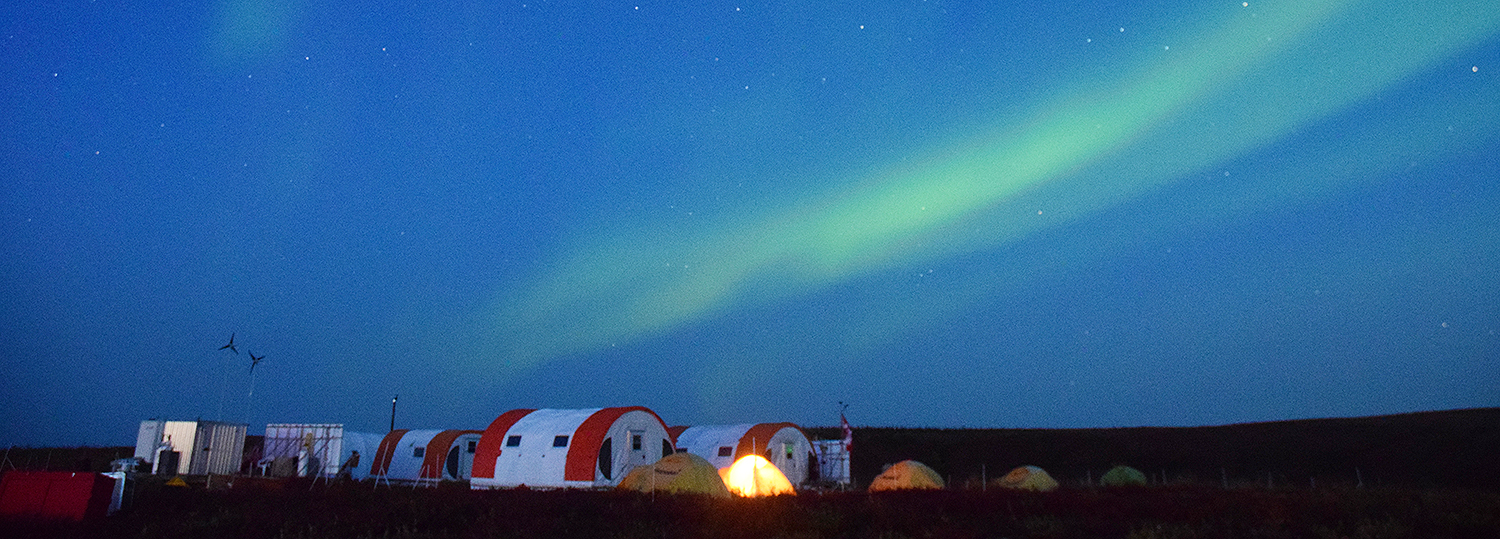
Nearly 4,000 km northwest of Wilfrid Laurier University’s southern Ontario campuses, where mainland Canada meets the Arctic Ocean, lies Trail Valley Creek Arctic Research Station. Located between Inuvik and Tuktoyaktuk, N.W.T., within the Inuvialuit Settlement Region, it is Laurier’s northern-most research station and this year marks its 30th anniversary.
Now the longest-running hydrologically focused Arctic research station in Canada, Trail Valley Creek has become a productive field site for Laurier’s Centre for Cold Regions and Water Science, which maintains more than 50 research sites north of Ontario’s Ring of Fire. It is also central to the university’s decade-long partnership with the Government of the Northwest Territories. Dedicated to understanding and predicting environmental changes near the treeline in the western Canadian Arctic, the research station is an interactive training ground for Laurier students and hosts international collaborators from organizations including NASA and the University of Edinburgh.
Since 1991, Philip Marsh has been the steward of the station, first in his role as a research scientist at Environment Canada and since 2013 as a professor in Laurier’s Department of Geography and Environmental Studies and the Canada Research Chair in Cold Regions Water Science. As Trail Valley Creek Arctic Research Station marks three decades of climate change research, Laurier Campus magazine asked Marsh, his students and colleagues to reflect on the impact of this “living laboratory.”
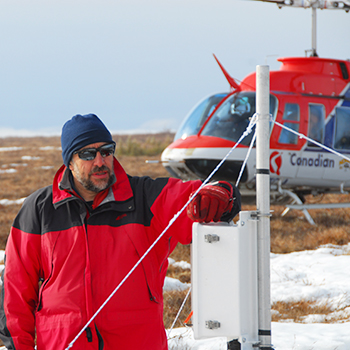
Philip Marsh has been the steward of Trail Valley Creek Arctic Research Station since 1991.
Marsh first travelled to Trail Valley Creek in the spring of 1991 while working at Environment Canada. He co-founded the research station with his colleague, John Pomeroy, now a professor at the University of Saskatchewan and the director of Global Water Futures, the largest university-led freshwater research project in the world.
Pomeroy: At the time, I was a young research scientist and had just joined the National Hydrology Research Institute of Environment Canada. Phil had been there for several years. He and I had worked on Cornwallis Island near Resolute Bay the year before on a snow hydrology study and we decided it would be interesting to focus on a site on the mainland with better logistics. We were looking for a site along the treeline that would be more directly subject to climate change, which we were already experiencing and felt that there would be more to come.
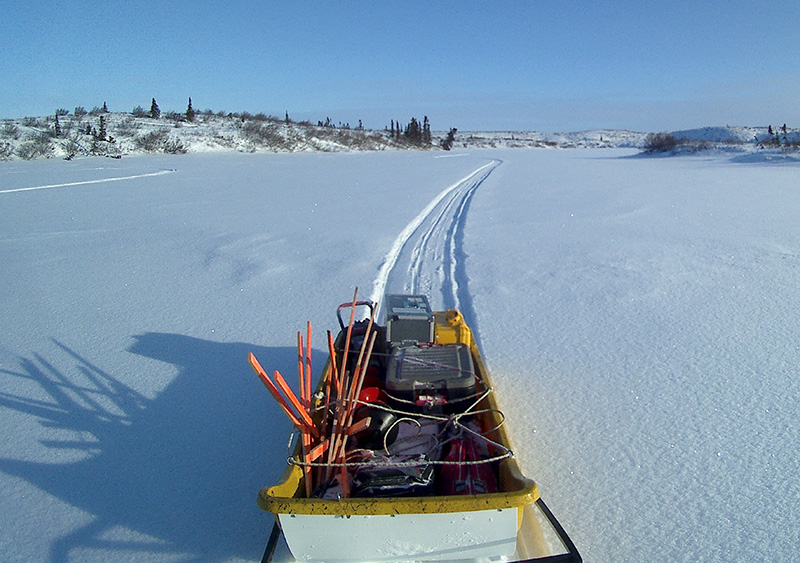
Marsh: We wanted to do fundamental hydrological studies and Trail Valley Creek met all of our requirements. It was one of the few streams in a tundra environment that had existing discharge measurements because Water Survey of Canada started taking measurements there in 1979 to support the development of a highway from Inuvik to Tuktoyaktuk.
Pomeroy: We flew to Inuvik in April 1991. Along with Phil and I, we brought a technician, Bob Reid, and one of Phil’s postdoctoral researchers, Lance Lesack.
We did an aerial reconnaissance and then we rode Ski-Doos out to Trail Valley Creek. It was a big adventure to get there: several hours on snow machines on trails we didn’t know, pulling all of our supplies on sleds.
William Quinton, now a professor of Geography and Environmental Studies at Laurier, was the first of many students to complete research at Trail Valley Creek.
Quinton: I was Phil’s first PhD student and went to Trail Valley with him in the fall of 1991. I returned for the next three summers to complete my PhD work studying runoff and other summertime hydrological processes.
The research station was nothing like it is now; it was basically just two large tents. The area around Trail Valley Creek was busy when snow was on the ground because it’s very close to the main snowmobile route between Inuvik and Tuktoyaktuk and close to the Husky Lakes. Locals would stop in at our camp on their way past. One man left us a caribou leg and we gave him a kilogram of salt. That kind of stuff went on all the time.
While working for Environment Canada, Marsh and Pomeroy built an active field research program at Trail Valley Creek.
Marsh: Initially we weren’t focused on a specific goal, other than scientific understanding, and we just planned to carry out studies there for a few years. But then a number of other projects came along.
Pomeroy: During the winter of 1991 to 1992, we brought in a group of researchers from the U.K. and Quebec to look at acid snow. The USSR still existed in 1991 and the Arctic was being heavily polluted by sulphuric acid from Soviet and Eastern European power and industrial plants. We started measuring the chemistry of snow packs and it was shocking: there was as much sulphuric acid build-up in those snow packs as you would expect outside of Detroit. We found that it was concentrated by blowing snowstorms into drifts and the big drifts often piled up in the treeline forests and became problematic for the ecosystem. We published our results and, following the collapse of the Soviet Union, the problem has been largely addressed because of changing governments in Russia and the introduction of pollution controls to their plants. I think our study probably helped make the case for controlling acid precipitation at the time.

Marsh: The Mackenzie GEWEX (Global Energy and Water Exchanges) Study, which was focused on the Mackenzie River Basin and sought to predict changes to Canada's water resources arising from climate change, funded work at Trail Valley Creek for a 10-year period in the mid-90s to the early 2000s. Then the International Polar Year came along and Trail Valley Creek was a premiere spot for the kind of polar regions studies being launched around the world, so we had another few years of work from that. One organization after another saw the unique type of work that we were doing at Trail Valley Creek and kept it going. Gradually we realized, ‘Oh – it’s no longer two years of data from this site. We have 10 years of data, and then 20 years of data,’ which is really useful.
In 2012, Marsh was approached to join Laurier.
Quinton: An opportunity came up at Laurier for a Canada Research Chair in Cold Regions Water Science and I encouraged Phil to apply. I remember him saying to me on the phone, ‘You know, at this point I don’t know whether to retire and just say this is the end of Trail Valley Creek or to carry on.’
Marsh: Working at Laurier appealed to me for two reasons: its research partnership with the Government of the Northwest Territories, which would give me a greater opportunity to take the research I had done and apply it to things that matter to communities, and the Centre for Cold Regions and Water Science, which I had known of for a long time as a great centre that brought together a range of cold regions research.
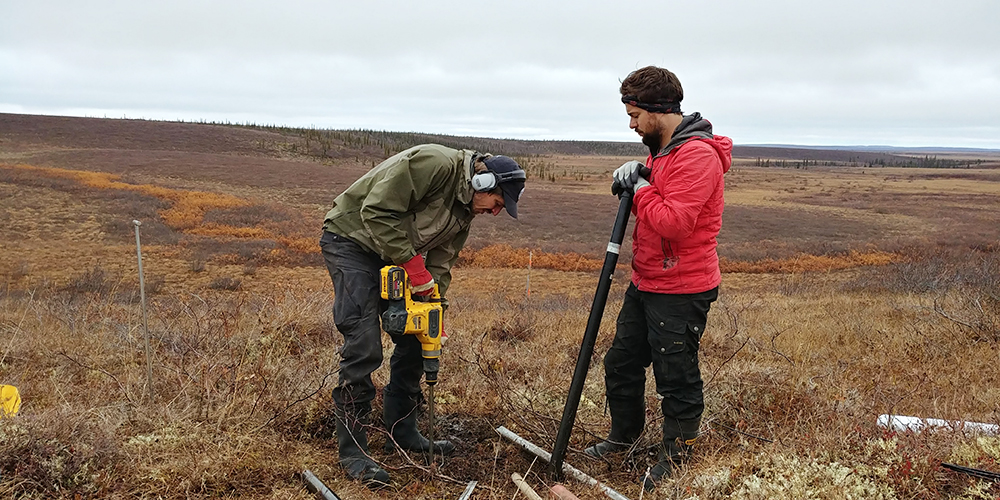
When Marsh came to Laurier in 2013, the university signed a land reserve agreement with the Government of the Northwest Territories through the Aurora Research Institute and is now responsible for operating and maintaining the land where the research station sits. Laurier also signed a long-term agreement with one of the Inuvialuit co-management boards to ensure collaborative decisions about research priorities on their territorial lands.
Branden Walker, then a third-year undergraduate student and today a research associate and station manager, travelled to Trail Valley Creek with Marsh in August 2014 to start rebuilding the camp.
Walker: It started small. We built one platform with an insulated, semi-permanent tent with a heater inside. We would have 12 people in there, basically sitting elbow to elbow. After doing that for a month straight without showering and working hard every day, things are a little gross and people need some space. So pretty much every year since then we have added another tent or a large piece of infrastructure.
Marsh: The camp can now comfortably house up to 15 people at a time in all weather conditions. It has three large, soft-shelled buildings that are called Weatherhavens. We have satellite internet access, individual sleeping tents, and a big power system that uses solar, wind and a diesel generator to produce electricity. Our instrumentation across the watershed has become very sophisticated. We use drones and aircrafts for carrying out detailed remote sensing. And, of course, the camp is protected by a bear fence. Trail Valley Creek is one of the few places in Canada where black, grizzly and polar bears can overlap.
– Philip Marsh
The location and sophistication of the research station enables a wide range of multidisciplinary research.
Marsh: Broadly, the focus of our research is on understanding and predicting the impacts of climate change. The area we’re studying is probably warming as fast as anywhere else in the northern hemisphere. People say the average global temperature increase since pre-industrial times is maybe 0.9 degrees Celsius. In the Inuvik area, it’s probably warmed closer to three degrees, so it’s warming at two to three times the global average.
We are using the 30 years of data we’ve collected to test new predictive models for the water cycle in the region. Local communities really want to know what is going to happen in the future with the lakes they use. Are they going to dry out or overflow? What’s going to happen when permafrost thaws? We are trying to answer questions at a very local level, but also provide answers at a territory-wide level as well. In the 1990s, our work was just straight hydrological research, but now we work with Laurier colleagues like Jennifer Baltzer on a much more integrated approach to understanding ecosystem change. Jennifer brings the ecology side of research to the table.
Baltzer (associate professor of Biology, Canada Research Chair in Forests and Global Change): Trail Valley Creek is right at what we call an ecotonal transition between forest and tundra. When we think about the direct impacts of climate change on northern ecosystems, one is changes in vegetation at these ecotonal transitions, so this is a great place to be studying. At the site, trees are showing increases in growth that are attributable to shortening winters, shortening snow cover periods and warming winter temperatures.
Student-led research is a core tenet of the Trail Valley Creek Arctic Research Station, offering early researchers access to a one-of-a-kind field site with three decades of existing data.
Walker: We often have undergraduate volunteers working with a graduate student who is directing a project, and then a primary investigator like Phil who is really knowledgeable about the bigger picture and the theory. So you have this mixing of different expertise that is pretty unique. You learn a lot that way.
Marsh: Our long-term data record at Trail Valley Creek is an asset for students because instead of starting from scratch, they see themselves adding to this long legacy. And because we have a lot of international collaborators, they get a wide variety of exposure.
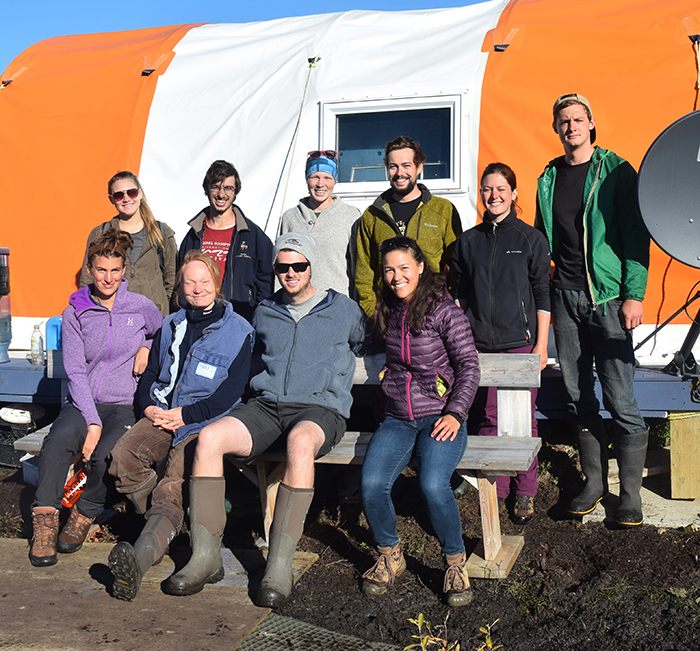
Researchers gather for a photo at Trail Valley Creek Arctic Research Station.
Despite being a milestone year for the Trail Valley Creek Arctic Research Station, all on-site research activity has been paused since March 2020 due to the COVID-19 pandemic.
Marsh: The pandemic has had dramatic impacts on our research. We cancelled an international field program and several teams of researchers over the past several months. We have done snow surveys at Trail Valley Creek every year since 1991. The 30th anniversary was the first year that we didn’t carry them out.
Walker: It’s all part of the fieldwork experience – being flexible and having backup plans and not getting too upset when things don’t go your way, because it’s almost guaranteed not to go your way. It's been challenging, but we’re hoping we can get up there soon to continue our research.
As it has for three decades through funding gaps and Arctic snow storms, Trail Valley Creek Arctic Research Station will weather its latest challenge. Marsh’s Canada Research Chair was recently renewed for another seven years and Laurier remains committed to its field-leading cold regions research program.
Baltzer: Trail Valley Creek is kind of Laurier’s northern anchoring site. It provides an important northern endpoint to what is a pretty terrific network of research and monitoring sites throughout the Northwest Territories.
Quinton: Before Phil arrived at Laurier in 2013, Laurier’s research activities were clustered in the southern part of the Northwest Territories. When we recruited Phil, that put a definite dot on the map way up north. It was a different landscape, there were different scientific questions being posed there and he had his own group of collaborators. He has expanded the site since then. He was able to hit the ground running and Laurier has been the beneficiary.